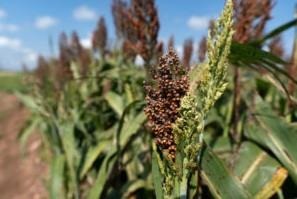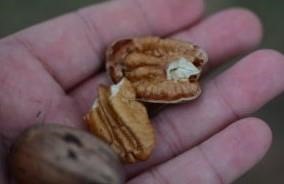The sugarcane aphid, a once devastating pest for sorghum producers, has been kept under control so far during the 2021 season by nature and science.

From the Rio Grande Valley to the Panhandle, Texas A&M AgriLife Extension Service reports show the fight against sugarcane aphids continues to tip in favor of producers. However, they say some producers remain hesitant about planting sorghum after years of severe losses when sugarcane aphids became an annual threat.
Sugarcane aphids devastated grain sorghum after the invasive species was first recognized in Texas crop fields in 2013. Infestations cut yields by 50%-70% and wiped out entire fields in extreme instances. Aphids also produce a honeydew excretion that inhibited harvest and damaged harvesting equipment.
But 2021 has been a very light-infestation year so far. And while the weather helped, AgriLife Extension experts say scientific breakthroughs with hybrid sorghum plants that are tolerant of the pest and an increased understanding of the aphid and how to manage fields to prevent major infestations continue to show effectiveness.
Danielle Sekula, AgriLife Extension integrated pest management specialist, Weslaco, said the sugarcane aphid migration was set back by Winter Storm Uri in February. Freezing conditions knocked back pest populations and killed early planted sorghum acres in Texas and across the border in Mexico.
Sugarcane aphid populations typically start building in those early planted fields, and pest pressure in South Texas fields begins building by mid-April, Sekula said. This year, sugarcane aphid populations did not begin building until mid-May.
“It’s like the freeze wiped the slate clean,” she said. “We were producing about the same time as the producers in Mexico, so it really reduced the populations and delayed their migration.”
Sorghum varieties, other factors keep sugarcane aphids in check
Sugarcane aphid numbers historically peak in South Texas by the second week in June, but populations did not reach spray thresholds this season until July 13. Rain and cloudy, cooler days also delayed the pests, which prefer high temperatures and humidity, and their migratory progress, Sekula said.
Spray treatments, a strong buildup of beneficial insect numbers and aphid-resistant sorghum varieties contributed to the lighter than usual infestations.
Sekula said pest-resistant hybrids developed after sugarcane aphids arrived and dealt producers serious losses have contributed significantly to below-normal populations. Those varieties continue to show their value as a tool to deter population explosions.
“It was like night and day,” she said. “We saw sugarcane aphids in Johnson grass all around sorghum with resistant varieties, but the fields were empty.”
Texas Plains on high alert
Pat Porter, Ph.D., AgriLife Extension entomologist, Lubbock, said sugarcane aphids are being reported throughout the Texas Plains and north of Amarillo but that numbers have increased slowly. Some fields have been treated, others are being monitored for spray thresholds and some will not require pesticides to prevent the sugarcane aphids from reaching damaging numbers.
Porter said proactive regimens by producers that include timely spraying, encouraging beneficial aphid predators and planting resistant sorghum varieties throughout the pest’s migration have helped keep their numbers in check.
The latest AgriLife Extension Plains Management News by Blayne Reed, AgriLife Extension integrated pest management agent, Hale County, echoes the assessments. He reported receiving two to four calls daily from producers, grain elevator operators, industry representatives and media about the pest and a “very alert” region due to the number of late-maturing grain sorghum acres.
But Reed also noted sugarcane aphids were behaving much more like a common pest now than the once-upon-a-time nightmare for sorghum producers.
Porter said continued success against sugarcane aphids has helped boost sorghum acres, but that acreage remains down due to lingering memories of severe losses from the pest.
“Producers generally know they are there, but we know how to deal with them now,” he said. “They are starting to realize they can plant under the threat of aphids.”
AgriLife Extension district reporters compiled the following summaries:

CENTRAL
No report.
ROLLING PLAINS
Conditions were extremely hot and windy. Topsoil moisture was declining, with some areas reporting very short moisture levels. Some areas received decent rains. Pastures were looking good for August, but armyworms and grasshoppers were a problem over the last few weeks. Some producers were cutting hay to prevent losses to armyworms while others were spraying. Cattle continued to graze, but some pastures were turning brown. Herds looked good but calf gains slowed due to hot weather and lack of moisture. Irrigated cotton was in fair to good condition while dryland fields were fair. Fleahopper numbers were increasing. Some Sudan fields looked decent with short but thick stands that were making good hay. Corn harvest was underway, and yields varied significantly according to rainfall received. Sorghum fields were coloring.
COASTAL BEND
Hot and very humid conditions prevailed. It was mostly dry, but some isolated showers delayed fieldwork. Grain sorghum harvest was mostly complete except for a few late-planted fields or where fields were wet. Corn harvest was underway. Cotton fields looked good, and pickers were running. Numerous fields required a second shot of defoliant and will be ready to harvest soon. Hay making was in full swing, and some areas were reporting record-breaking yields. As a result, there should be a hay surplus for this winter. Rangeland and pasture conditions were about as good as they could be, especially for August. Cattle remained in good condition with prices steady to higher.
EAST
Subsoil and topsoil conditions were adequate. Hay production was still in full swing for much of the district. Some areas received adequate rainfall to keep things moving, while others needed more. Pasture and rangeland conditions were good. Spring gardens were turned under a little later than normal due to weather conditions. Marion County reported fall gardens were being planted. Cattle markets remained strong. Livestock were doing fair to good. Producers continued to battle armyworm infestations. Wild pigs caused damage to hay meadows and pastures.
SOUTH PLAINS
Subsoil and topsoil moisture increased due to slow, soaking rains. Cotton stages continued to be highly variable. Cotton aphids have continued to spread across most of the area. Grain sorghum maturity varied as well. Peanuts continued to make good progress, and most fields were past flowering. Cattle were in good condition.
PANHANDLE
Hotter, drier and windier conditions reduced crop and rangeland conditions. Producers with irrigation were watering. Summer fallow fields were being plowed or sprayed for weeds. Topsoil and subsoil moisture levels were short to adequate. Sorghum and cotton conditions were fair to good in most areas. Corn was in good to excellent condition. Soybean conditions were fair to excellent. Peanut conditions were good.
NORTH
Soil moisture was adequate in some counties and short in others. No rain was reported, and soils were drying. Temperatures were higher, and the grass growth slowed. Some hay producers were finally getting around to cutting. More rain was needed to help add some growth to the pastures. A second hatching of armyworms were emerging. Grain sorghum, corn and cotton looked good. Soybean conditions were not as good. Livestock were in good condition, and spring-born calves were growing.
FAR WEST
Areas around Big Bend National Park received widespread rainfall over the past week with 0.5-2 inches. Temperatures were cooler, with lows in the mid-60s and highs in the low- to mid-80s. Very few parts of the area experienced the 100-degree daytime temperatures typical of this time of year. High winds were causing some damage. Rangeland conditions were continuing to improve under milder temperatures. Producers continued to water cotton, and flowering was underway. Most livestock were sorted and ready for sale. Producers continued to feed livestock and wildlife.
WEST CENTRAL
Much-needed rain improved soil moisture levels. Rains improved rangeland conditions as well. Pecan and cotton crops continued to progress. Insect pest problems continued, especially grasshoppers and armyworms. Some producers finished baling hay grazer fields. Sorghum harvest was beginning. Large volumes of cattle were going to market with steers weighing 700-800 pounds, fetching the mid-$150s to the low-$160s per hundredweight.
SOUTHEAST
Conditions were drier. Farmers were cutting rice and looked to increase harvesting operations as conditions continued to dry. Fewer areas received rains. Some areas were showing signs of moisture stress. Armyworms were in pastures. Scattered showers made hay harvest risky, but some producers found windows to cut, cure and bale. Rangeland conditions ranged from very poor to excellent, with good ratings most common. Soil moisture levels were very short to adequate.
SOUTHWEST
Temperatures were seasonal, with scattered rainfall reported across the district. Rangeland and pasture conditions looked good. Spraying of brush slowed. Sorghum harvest was almost complete, and corn harvest was underway. Hay bailing continued with good yields reported. Some producers were on their second cutting and even planning a third. Cotton looked good. Livestock were in good to fair condition. Producers were weaning calves and taking lambs and kid goats to market. Cattle prices were going up, and sheep and goat prices were strong. Wildlife were in good condition. Most fawns have lost their spots, and buck antler growth was slowing. Fall gardeners were planting.
SOUTH
Higher temperatures and scattered showers continued throughout the district. Temperatures were mostly in the high 90s. Kleberg and Kenedy counties reported trace amounts of rain up to 0.75 of an inch and surplus soil moisture levels. Soil moisture conditions were mostly adequate with reports of declining moisture and short topsoil moisture levels. Zavala County reported that field conditions need to dry some before producers can access them. Conditions were favorable in most areas for corn and sorghum harvests that continued but yield and crop damage reports were all over the board. Some grain fields were still inaccessible due to wet conditions. Peanut and cotton fields continued to develop well. Cotton harvest was underway in some areas, and producers continued to prepare for harvest in other areas. Cotton field defoliation was ramping up. Cotton yields were showing promise, and modules were beginning to arrive at gins. Pastures remained full of decent-looking native grasses, but conditions were declining. Southern parts of the district were reporting excellent pasture and rangeland conditions. Tuna berries on cactus continued to feed livestock and wildlife. Sorghum food plots had dried down, and native sunflowers were ready for dove season. Hotter, humid conditions were stressful on livestock and wildlife. Cattle producers were beginning to sell spring calves and seeing good prices. Hay producers were making a second cutting, and a few were making a third. Yields were up, but quality was down due to maturity. Hay prices were back to normal — $40-$50 per round bale. Some producers were providing cubes and mineral supplements to livestock. Stock tanks were still in good condition. Irrigated Coastal Bermuda grass fields continued to produce good bales. Pecan orchards were in good condition, and good yields were expected. Watermelons and cantaloupes continued to produce. Sesame harvest started. Some citrus trees continued to make a comeback. However, there will not be a citrus crop to harvest this season due to the damage caused by Winter Storm Uri.
Source : tamu.edu